
Cytisus is a genus of flowering plants in the family Fabaceae, native to open sites in Europe, western Asia and North Africa. It belongs to the subfamily Faboideae, and is one of several genera in the tribe Genisteae which are commonly called brooms. They are shrubs producing masses of brightly coloured, pea-like flowers, often highly fragrant. Members of the segregate genera, Calicotome, Chamaecytisus, and Lembotropis are sometimes included in Cytisus.

Genista stenopetala, the sweet broom, Easter broom or leafy broom, is a species of flowering plant in the legume family Fabaceae, native to the Canary Islands, on La Palma and Tenerife.
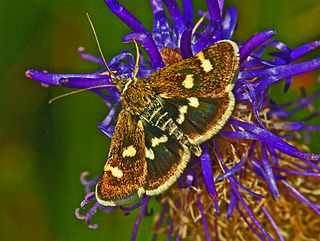
Eurrhypis pollinalis is a species of moth of the family Crambidae. It was described by Michael Denis and Ignaz Schiffermüller in 1775.

Rhodostrophia calabra is a moth of the family Geometridae first described by Vincenzo Petagna in 1786. It is found from the Iberian Peninsula and a small isolated population in Morocco, through southern France, the western and southern Alps, Italy, the eastern coast of the Adriatic Sea to the southern parts of the Balkan Peninsula. In central Europe it is only found as an isolated population in central France and Rheinland-Pfalz. It is not found on the islands in the Mediterranean Sea. In the Balkans there is an isolated population in the border region of northern Bulgaria and Serbia. Furthermore, it is present on the eastern shores of the Black Sea in Turkey and in the Caucasus.
Cydia medicaginis, the alfalfa moth, is a moth of the family Tortricidae. It is found in northern and central Europe, Transcaucasus, Kazakhstan and from western Russia to southern Siberia.
Phyllonorycter triflorella is a moth of the family Gracillariidae. It is known from France, Corsica, Sardinia, Italy and Croatia.

Phyllonorycter staintoniella is a moth of the family Gracillariidae. It is found from Sweden to the Pyrenees, Sardinia, Italy and Bulgaria and from Great Britain to Poland and Romania.

Micrurapteryx kollariella is a moth of the family Gracillariidae. It is known from all of Europe, except the British Islands and Fennoscandia.
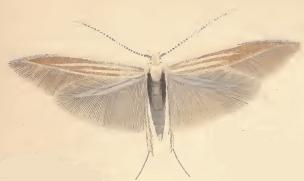
Coleophora trifariella is a moth of the family Coleophoridae. It is found from Germany and Poland to the Iberian Peninsula and Italy and from France to Romania. There is a disjunct population in Belarus. It is also known from Turkey.
Coleophora saturatella is a moth of the family Coleophoridae. It is found from Sweden to the Pyrenees, the Alps and Albania and from Great Britain to Romania. It has also been recorded from southern Russia.

Agonopterix atomella is a moth of the family Depressariidae. It is found in most of Europe.
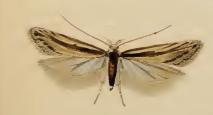
Mirificarma mulinella is a moth of the family Gelechiidae. It is found in most of Europe, except Finland, the Baltic region and part of the Balkan Peninsula. It has also been recorded from North Africa.

Mirificarma cytisella is a moth of the family Gelechiidae. It is found from most of Europe to the Ural Mountains.
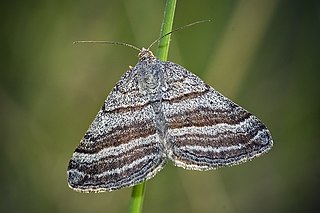
Scotopteryx coarctaria is a species of moth in the family Geometridae. It is found in most of Europe, except Ireland, Great Britain, Portugal, Belgium, Fennoscandia and the Baltic region. It has also been recorded from Turkey and Kazakhstan.
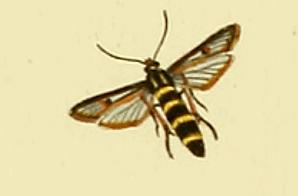
Bembecia megillaeformis is a moth of the family Sesiidae. It is found in central and south-eastern Europe, east to Turkey, Uralsk, the Crimea and the Black Sea.
Prolita solutella is a moth of the family Gelechiidae. It is widely distributed throughout Europe, east to the Ural mountains. It is also found in Turkey. The habitat consists of dry pastures and dry heathland.

Periclepsis cinctana, the Dover twist, is a species of moth of the family Tortricidae found in Europe. It was first described by Michael Denis and Ignaz Schiffermüller in 1775.
Syncopacma cincticulella is a moth of the family Gelechiidae. It was described by Charles Théophile Bruand d'Uzelle in 1851. It is found in Asia Minor and southern and south-eastern Europe, where it has been recorded from Spain, France, Germany, Austria, Switzerland, Italy, the Czech Republic, Slovakia, Hungary, Romania, Poland, Ukraine and Russia.

Genisteae is a tribe of trees, shrubs and herbaceous plants in the subfamily Faboideae of the family Fabaceae. It includes a number of well-known plants including broom, lupine (lupin), gorse and laburnum.







